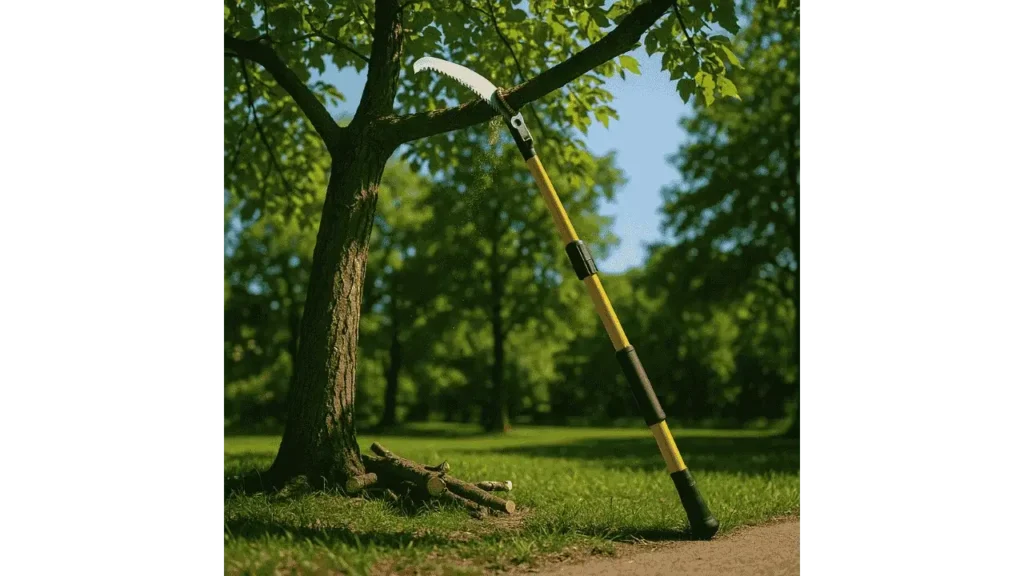Pole saws have changed the way I approach yard work. These long-reach cutting tools are designed for pruning tall branches and overgrown shrubs without ever stepping onto a ladder. As someone who has spent years maintaining landscapes, I’ve come to rely on pole saws not just for their convenience but for the precision and safety they bring to routine trimming tasks. Whether you’re dealing with storm damage, shaping hedges, or keeping trees healthy, a pole saw is a smart addition to your garden arsenal.
Primary Uses
High Branch Trimming
One of the most common uses for a pole saw is safely trimming limbs above shoulder height. Instead of climbing, you can stay grounded and still reach branches ten or more feet high. This is especially useful for maintaining tree shape or removing dead limbs that pose a danger.
Shrub and Bush Pruning
Pole saws aren’t just for tall trees. When dense or tall shrubbery becomes unruly, a pole saw helps shape and maintain it cleanly. It allows you to reach deep without stepping into the bush or pulling out a ladder, keeping the process safe and efficient.
Storm Cleanup
After a storm, fallen or broken branches are common. Pole saws let you handle post-storm cleanup quickly and safely, especially when branches are still hanging or tangled. I’ve used mine right after windy nights to clear my driveway without hassle.
Secondary and Specialized Applications
Utility and Cable Line Clearance
Utility professionals often use pole saws to trim branches around power lines. While homeowners should steer clear of utility poles, it highlights the tool’s precision and reach in narrow or elevated spaces.
Selective Tree Thinning
If your tree canopy is too dense, selectively removing small-to-medium limbs with a pole saw improves airflow and sunlight penetration. It’s a smart way to promote healthier growth without over-pruning.
Hedge and Topiary Work (with Attachments)
Some pole saws allow attachments like hedge trimmers. This turns them into multi-use garden tools ideal for topiary styling or maintaining tall hedges without needing multiple tools.
Advantages Over Other Tools
Safety Without Ladders
Pole saws dramatically lower your fall risk. You can complete pruning tasks while standing on solid ground. No need to balance on a ladder with a sharp blade, a real win in both safety and sanity.
Extended Reach
With telescopic poles, many models can extend from 8 to 15 feet. This is enough to reach most backyard trees and hedges without any additional equipment.
Variety of Power Options
There’s a pole saw for every job. Manual saws are great for light work, while electric, battery-powered, and gas models provide cutting power for everything from small branches to thick limbs.
“For homeowners with varied needs, having both a manual and a battery-operated pole saw covers 95% of all seasonal yardwork,” advises Ken Mueller, Certified Arborist.
Choosing the Right Tool for the Job
Branch Size and Thickness
Thinner branches (under 3 inches) can be handled with manual or small electric saws. Thicker limbs may require a gas-powered unit. Match your tool to the work to avoid straining the motor or your arms.
Frequency of Use
If you frequently prune or manage larger properties, gas-powered models are a worthwhile investment. For occasional use, cordless electric versions are quieter, lighter, and more convenient.
Yard Size and Power Source
If you have a small yard near outlets, a corded pole saw works fine. For larger properties or remote spots, cordless tools give you the freedom to move around.
“Pole saw selection depends not just on tree height but also terrain and mobility needs,” explains Lisa Conway, Landscape Equipment Consultant.
Safety and Best Practices
Wear Protective Gear
Always gear up before you prune: goggles for eye safety, gloves for grip, a helmet for overhead branches, and sturdy footwear to prevent slips.
Clear Work Area
Before you start cutting, make sure no one is standing below the branches. Even small limbs can injure someone when they fall.
Plan Cuts Thoughtfully
Don’t rush. Cut one branch at a time, working at safe angles, and keep an eye on where each piece might fall. Avoid cutting near power lines; leave that to professionals.
Final Takeaways
Pole saws have become an essential part of my gardening toolkit, and once you try one, you’ll see why. From trimming towering trees to tidying up unruly shrubs, they let you get the job done safely, efficiently, and with both feet on the ground. Choose the model that suits your yard and cutting needs, wear the right gear, and follow proper practices. You’ll not only protect your property and plants, but you’ll also gain the satisfaction of doing it all with confidence and control.
- How to Cut a Straight Line with a Jigsaw? - October 31, 2025
- How to Cut a Circle with a Jigsaw? - October 31, 2025
- Can You Cut Acrylic with a Jigsaw? - October 31, 2025
